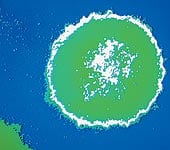Life Extension Magazine®
Stem Cells May Help Treat Heart Disease | |
Bone marrow-derived stem cells are safe and effective in the treatment of advanced heart disease, according to presentations by several independent research teams at the American Heart Association 2005 Scientific Sessions in Dallas, TX.* The use of stem cells derived from bone marrow to treat damaged cardiac tissue following myocardial infarction is referred to as cellular cardiomyoplasty. Volker Schachinger, MD, of J.W. Goethe University in Frankfurt, Germany, presented the results of one such study. Schachinger and colleagues found that recipients of bone marrow-derived stem cells significantly improved their left ventricular ejection fraction, a measure of the pumping efficiency of the heart. Left ventricular ejection fraction generally declines over time in those who have had a myocardial infarction, as a result of cardiac cell death and scar tissue formation. This progressive deterioration in heart function can ultimately lead to heart failure, a major cause of disability and premature death in the US. One hundred nine patients with stable ischemic heart disease enrolled in the study. The patients averaged 59 years in age and had had a documented heart attack between three months and 12 years earlier. In the subgroup of patients who received an in-fusion of bone marrow-derived stem cells, the left ventricular ejection fraction increased by 3.1%, a clinically significant improvement. Moreover, the size of the infarct area decreased, suggesting significant repopulation of heart cells by bone marrow-derived stem cells. By contrast, the left ventricular ejection fraction decreased by 1.2% in the control group that did not receive stem cells. Thus far, studies have shown that the beneficial effect of bone marrow-derived stem cell infusion persists for six to 24 months. Ongoing clinical trials are investigating the optimal conditions for bone marrow-derived stem cell infusion, including the route of infusion, number of cells to infuse, and timing of infusion. While Dr. Schachinger’s study involved patients with chronic heart disease, bone marrow-derived stem cell infusion has been demonstrated to improve symptoms as early as four days after a myocardial infarction. Bone marrow-derived stem cell infusion appears to be both safe and effective, with no associated reports of side effects such as rejection, inflammation, or arrhythmia. —Linda M. Smith, RN | |
| Reference | |
| * Available at: http://www.medscape.com/ viewarticle/517528. Accessed January 6, 2006. | |
High Carotenoid, Selenium Levels Reduce Mortality Risk | |
| A report published in the Journal of Nutrition reveals that older women with higher serum levels of carotenoids and selenium have a lower risk of dying over the course of five years than women whose levels of these nutrients are low.* Selenium is a trace mineral found in small amounts in plant and animal foods. Carotenoids occur in plant foods and include alpha carotene, beta-carotene, lycopene, lutein, and zeaxanthin. Researchers at Johns Hopkins analyzed data from 632 women aged 70 to 79 who enrolled in the Women’s Health and Aging Studies I and II. The studies were designed to evaluate the causes and course of physical disability in older community-dwelling women. Selenium and carotenoid levels were measured upon enrollment, and participants were followed for five years. At the end of the follow-up period, 14% of the women had died. Primary causes of death included cardiovascular disease, cancer, stroke, infection, chronic obstructive pulmonary disease, and accidents. Those who died were older and more likely to be African-American, smokers, and overweight. Higher levels of selenium and individual and total carotenoid concentrations appeared to be protective against mortality. Women whose selenium or total carotenoid levels were in the lowest 25% of participants had a greater risk of dying than those whose levels were in the top 75%, and as nutrient levels increased, mortality rates decreased. For those who died, mean carotenoid and selenium levels were 1.40 and 1.43 micromoles per liter, compared to 1.72 and 1.54 micromoles per liter for those who survived. The authors noted that the underlying biological mechanism by which diminished levels of carotenoids and selenium contribute to an increased risk of death could be increased oxidative stress and inflammation. Serum carotenoid levels are considered to be the best marker for fruit and vegetable intake, and studies have shown that high intake of these foods reduces inflammatory biomarkers and protects against cardiovascular disease. Deficient selenium levels have been associated with atherosclerosis and increased oxidative stress. The authors concluded that their work “provides some early insight into the relation between antioxidant nutrients and mortality among older women,” and recommended further studies. —Dayna Dye | |
| Reference | |
| * Ray AL, Semba RD, Walston J, et al. Low serum selenium and total carotenoids predict mortality among older women living in the community: the Women’s Health and Aging Studies. J Nutr. 2006 Jan;136(1):172-6. | |
Life Extension Experts Address Anti-Aging Congress | |
| Several physicians affiliated with the Life Extension Foundation were among the featured presenters at the 13th Annual International Congress on Anti-Aging Medicine, held December 9-12, 2005, in Las Vegas, NV. The meeting was co-sponsored by the American Academy of Anti-Aging Medicine (A4M), a non-profit medical society dedicated to advancing technology, promoting research, and providing education for the purpose of optimizing the human aging process. The annual Congress is the world’s premier scientific conference on topics relating to medical interventions to prevent and treat diseases and disabilities associated with aging. Congress presenters examine a broad array of the most promising areas of preventive medicine, ranging from stem cell therapeutics and regenerative medicine to cardiovascular disease prevention and treatment, biomarkers of aging, and hormone replacement and vitamin therapies. This year’s meeting set a record for attendance, drawing more than 5,000 physicians, health care practitioners, business leaders, and other attendees from more than 50 nations around the world. As A4M Chairman Dr. Robert Goldman noted, “these 5,000 participants represent the most innovative pioneers in advancements in life enhancement and life extension medicine around the world.” Among the presenters affiliated with Life Extension were Sergey Dzugan, MD, PhD, and Steven V. Joyal, MD. Dr. Dzugan, president of Life Extension Scientific Information, Inc., presented “A New Theory of Migraine Treatment: The Simultaneous Restoration of Neurohormonal and Metabolic Integrity.” Dr. Dzugan previously published his experience with this groundbreaking, innovative, and extremely successful use of hormonorestorative therapy for high cholesterol and migraine management in 2002 and 2003 in the peer-reviewed journals Medical Hypotheses and the Bulletin of Urgent and Recovery Medicine, respectively. Dr. Joyal, vice president of scientific affairs at Life Extension, presented “Non-Surgical Obesity Treatment and Management: An Integrated Approach.” Dr. Joyal previously published an overview of obesity treatment strategies in the peer-reviewed journal Current Drug Targets in 2004. For more information on A4M and upcoming anti-aging conferences, please visit www.worldhealth.net. —Matt Sizing |





